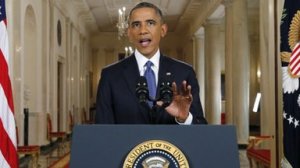United States State Department Submits President Obama’s Ambitious 2025 Target to Cut U.S. Climate Pollution by 26-28 Percent from 2005 Levels
Building on the strong progress made under President Obama to curb the emissions that are driving climate change and lead on the international stage, the United States today submitted its target to cut net greenhouse gas emissions to the United Nations Framework Convention on Climate Change (UNFCCC).
The submission, referred to as an Intended Nationally Determined Contribution (INDC), is a formal statement of the U.S. target, announced in China last year, to reduce our emissions by 26-28% below 2005 levels by 2025, and to make best efforts to reduce by 28%.
 Last November, President Obama and President Xi – leaders of the largest economies and largest polluters – made the historic announcement of the respective post-2020 climate targets for the United States and China.
Last November, President Obama and President Xi – leaders of the largest economies and largest polluters – made the historic announcement of the respective post-2020 climate targets for the United States and China.
For the first time, China committed to limit its greenhouse gas emissions, with a commitment to peak emissions around 2030 and to make best efforts to peak early, and to increase its share of non-fossil energy consumption to around 20 percent by 2030.
Following that historic announcement, the European Union put forward an ambitious and achievable INDC to cut their emissions 40% by 2030.
And just last week, Mexico announced that it would peak its overall net greenhouse gases by 2026, backed by strong unconditional policies and a new bilateral task force to drive climate policy harmonization with the United States.
With these actions, as well as strong INDCs submitted by Norway and Switzerland, countries representing over 50% of global CO2 emissions have either announced or formally reported their targets.
Today’s action by the United States further demonstrates real momentum on the road to reaching a successful climate agreement this December in Paris and shows President Obama is committed to leading on the international stage.
The U.S. target will roughly double the pace of carbon pollution reduction in the United States from 1.2 percent per year on average during the 2005-2020 period to 2.3-2.8 percent per year on average between 2020 and 2025.
This ambitious target is grounded in intensive analysis of cost-effective carbon pollution reductions achievable under existing law and will keep the United States on the pathway to achieve deep economy-wide reductions of 80 percent or more by 2050.
The Administration’s steady efforts to reduce emissions will deliver ever-larger carbon pollution reductions, public health improvements, and consumer savings over time and provide a firm foundation to meet the new U.S. target.
“Our leadership at the international level starts at home. In 2009, U.S. greenhouse gas emissions were projected to continue increasing indefinitely,” the Whitehouse said.
When entering office, President Obama set an ambitious goal to cut emissions in the range of 17 percent below 2005 levels in 2020.
Throughout the first term, the Administration took strong actions to cut carbon pollution, including investing more than $80 billion in clean energy technologies under the Recovery Act, establishing historic fuel economy and appliance energy efficiency standards, doubling solar and wind electricity, and implementing ambitious energy efficiency measures.
Early in his second term, President Obama launched an ambitious Climate Action Plan focused on cutting carbon pollution, preparing the nation for climate impacts, and leading on the international stage to bring nations large and small to the table to pledge to act on climate change.
In addition to bolstering first-term efforts to ramp up renewable energy and efficiency, the Plan is cutting carbon pollution through new measures, including:
•Clean Power Plan: The Environmental Protection Agency (EPA) proposed guidelines for existing power plants in June 2014 that would reduce power sector emissions 30% below 2005 levels by 2030 while delivering $55-93 billion in annual net benefits from reducing carbon pollution and other harmful pollutants.
•Standards for Heavy-Duty Engines and Vehicles: In February 2014, President Obama directed EPA and the Department of Transportation to issue the next phase of fuel efficiency and greenhouse gas standards for medium- and heavy-duty vehicles by March 2016.
These will build on the first-ever standards for medium- and heavy-duty vehicles (model years 2014 through 2018), proposed and finalized by this Administration.
•Energy Efficiency Standards: The Department of Energy set a goal of reducing carbon pollution by 3 billion metric tons cumulatively by 2030 through energy conservation standards issued during this Administration.
The Department of Energy has finalized multiple measures addressing buildings sector emissions including energy conservation standards for 29 categories of appliances and equipment as well as a building code determination for commercial buildings. These measures will also cut consumers’ annual electricity bills by billions of dollars.
•Economy-Wide Measures to Reduce other Greenhouse Gases: EPA and other agencies are taking actions to cut methane emissions from landfills, coal mining, agriculture, and oil and gas systems through cost-effective voluntary actions and common-sense regulations and standards.
At the same time, the State Department is working to slash global emissions of potent industrial greenhouse gases, called HFCs, through an amendment to the Montreal Protocol; EPA is cutting domestic HFC emissions through its Significant New Alternatives Policy (SNAP) program; and, the private sector has stepped up with commitments to cut global HFC emissions equivalent to 700 million metric tons through 2025.







Tina Okunmwendia liked this on Facebook.